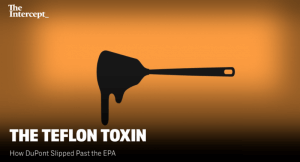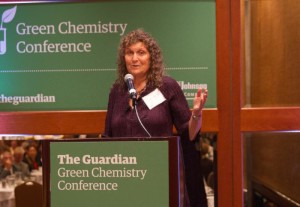September 2015: Fluorinated Chemicals Found in Babies: Why?
In this edition:
- Babies Exposed to Fluorinated Chemicals
- Health Harm from Drinking Water
- In the Future, the Best Chemistry Practices Will be Green
- PentaBDE Flame Retardant, Previously Used in Furniture, Can Cause Cancer

I’m back from presenting a talk on the Six Classes at the Guardian Green Chemistry Conference in New York and an August vacation on a very remote and beautiful coral island with great snorkeling 36 miles off the coast of Belize and hiking in the Cordillera of Columbia. This excellent short video from Greenpeace shows that sadly highly fluorinated chemicals are now found even in such remote and seemingly unspoiled places.
A number of thought-provoking articles on these chemicals as described below were published in the last weeks. Philippe Grandjean’s new paper found that babies’ levels for C8, a fluorinated chemical that was used to make Teflon, can increase by 20-30% each month of exclusive breastfeeding. Another Grandjean paper suggests that current limits for C8 in drinking water may be100 times too high to be health-protective. Sharon Lerner’s riveting series on “DuPont and the chemistry of deception” explores the high levels of cancer and other health problems in communities exposed to C8. Although C8 is no longer produced in the US, the major replacement is C6, which shares its structure and extreme persistence.
To better understand the forces opposed to decision-making based on science and the public interest , I recommend the highly entertaining movie Merchants of Doubt which links the illusions created by magicians to the tactics of the tobacco industry, climate change deniers, and flame retardant producers — a must watch.
Kind regards,
Arlene and the Green Science Policy team
Babies Exposed to Fluorinated Chemicals

Philippe Grandjean and colleagues’ new study finds that breastfeeding is a major source of highly fluorinated chemicals in infants. Concentrations of five fluorinated chemicals in the blood of babies increased by 20% to 30% per month when breastfed exclusively. Levels decreased once breastfeeding stopped.
However, according to epidemiologist Glenys Webster: “There are many important benefits of breastfeeding, which still far outweigh the risks. The real question is how do we reduce moms’ exposures in the first place?”
Since many fluorinated chemicals stay in our bodies for years, it is difficult for expectant mothers to avoid transferring the chemicals to their babies. The best solution is reducing the unnecessary uses of such chemicals in products, which will decrease everyone’s exposure. This is one objective of our www.SixClasses.org project. Check out our Consumers’ Guide to Highly Fluorinated Chemicals for hints on reducing your exposure.
Another recent study found that C8 causes adverse health effects at very low concentrations. According to an Environmental Working Group (EWG) report, the EPA’s current safety standard may be as much as 1000 times too high to protect health.
As part of its Unregulated Contaminant Monitoring Rule 3 (UCMR3) program, the EPA has been testing public drinking water for levels of C8 and other fluorinated chemicals. According to the EWG report, C8 was detected in 94 public water systems in 27 states – providing water to more than 6.5 million people – at levels between 5 and 137 times higher than the safe level estimated by EWG. EWG’s interactive map will show if your community’s water might have been tested and whether or not C8 was found.
Health Harm from Drinking Water

Sharon Lerner’s riveting three-part series tells the story of PFOA pollution in drinking water near a Teflon production plan in West Virgina. The Huffington Post published a similar piece a few days later.
Lerner’s expose includes details of DuPont’s 2004 class-action lawsuit settlement agreement, which established the C8 Science Panel to study the exposed population. The C8 Science Panel linked PFOA to six health problems: high cholesterol, ulcerative colitis, pregnancy-induced hypertension, thyroid disease, testicular cancer, and kidney cancer. About 3500 personal injury claims were filed as part of this settlement and the first will be heard this month.
As Lerner said, “perhaps the most remarkable and unlikely occurrence of all is not the fact that the contamination happened, or even that it turned out to be harmful, but that it was discovered…. Had the stars not aligned that way, C8 would still be largely unknown…”
In the Future, the Best Chemistry Practices Will be Green

At the Guardian Green Chemistry Conference in New York, Arlene presented the closing talk to industry leaders and academics The Six Classes: Policy & Purchasing to Drive Green Chemistry discussing how the Six Classed concept can help advance green chemistry. The meeting demonstrated that green chemistry has the potential to move us beyond petroleum-based chemistry, delivering both health and environmental benefits. However, the rate of this transition needs to be increased. You can read more about this informative meeting here.
PentaBDE Flame Retardant, Previously Used in Furniture, Can Cause Cancer

A National Toxicology Program (NTP) panel has issued areport showing “clear evidence of carcinogenic activity” of the flame retardant PentaBDE in animal studies. Human studies have also found reduced IQ, lower birthweight, and adverse neurological changes in children when their mothers were exposed to this flame retardant. Use of this chemical is currently banned in 150 countries.
PentaBDE was the major flame retardant used in foam furniture filling from 1975 until 2005 to meet California’s ineffective furniture flammability standard, TB117. Couches purchased during those years are likely to contain about 5% PentaBDE in their foam. Our Consumer Resources page contains tips on how to reduce flame retardants in your home.
Receive Updates By Email
Subscribe to our monthly newsletter and get these updates delivered right to your inbox!